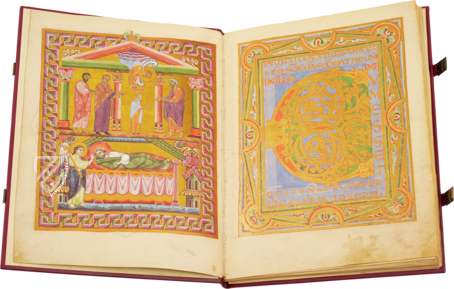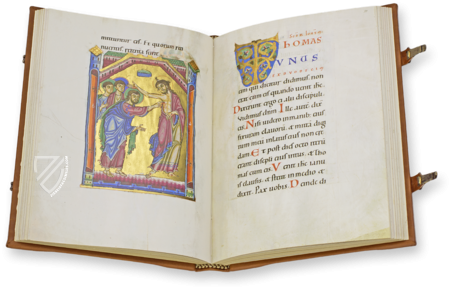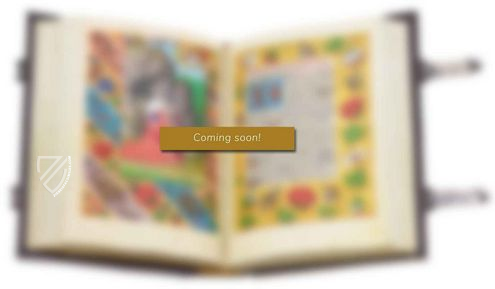Antiphonary of St. Peter
(3,000€ - 7,000€)
Used for special masses for almost 800 years in St. Peter's Abbey in Salzburg, the Antiphonary of Saint Peter is one of the finest manuscripts to survive the 12th century. Colorful miniatures on golden grounds as well as ornamental pages with luxurious golden initials on purple grounds illustrate the liturgical text. Twelve richly embellished calendar pages, two Easter tables, and pen drawings on green and blue grounds adorn the manuscript, much like the more than 400 decorated initials mostly containing motives of flora and fauna. The script of the text is written with surprising uniformity considering that it is the work of a team of artists. This Romanesque manuscript has clear stylistic influences from Byzantine illumination, especially with regard to its burnished gold and purple-dyed backgrounds.
Antiphonary of St. Peter
The Antiphonary of Saint Peter in Salzburg is a work of art of such high rank that only very few other liturgical books equal it. It was used for almost 800 years in Saint Peter’s Abbey for masses on solemn occasions, and kept in the library or the treasury of the monastery for the rest of the year. In addition, the Antiphonary constitutes one of the most impressive manuscripts of the 12th century, both in terms of size and volume, with a total of 846 pages and a format of 433 x 310 mm. As it was not soley destined for practical use, but also for dignified representation, its decorative apparatus outshines all other achievements of illumination from this period. Colorful miniatures on golden grounds as well as ornamental pages with luxurious golden initials on purple grounds illustrate the liturgical text. Twelve richly embellished calendar pages, two Easter tables, and pen drawings on green and blue grounds adorn the manuscript, much like the more than 400 decorated initials mostly containing motives of flora and fauna.
The Illumination
Six full-page and two half-page miniatures form the most luxurious and elaborate portion of the manuscript’s illumination. They are executed in opaque colors and framed with colorful ornamental borders. The figures are painted in warm colors on delicately shimmering golden backgrounds made from pulverised gold which, imitating the Byzantine method, was applied with a brush on a thin layer of glue. A further highlight are the eight ornamental pages showing elaborate luxurious full-length initials on purple grounds. The letters are frequently formed of gold and silver interlace and ornate with coloured flowers. They are occasionally enlivened with animals and human figures.
Pen Drawings on Colored grounds
The Antiphonary of St. Peter also deserves special attention for its well-balanced combination of opaque paintings and pen drawings. An essential technical feature of the 49 pen drawings is the use of two colored inks corresponding to the two inks mainly used for the written text. They all stand out against blue and green backgrounds, which gives the drawings their graphically coherent form.
Numerous Initials Enliven the Text
Over 400 decorated initials painted before green and blue grounds enrich the book with great variety and imagination. The modesty of the backgrounds enhance their delicateness and makes them fit into the overall impression of the written page. Vines, foliage and flowers adorn the letters and occasionally, naturalistically-drawn animals nesting in intertwined vines are to be observed.
The Calendar
The twelve calendar pages are also richly embellished, each showing two busts of saints and a zodiac. The texts on each page are introduced by two hexameters the contents of which appears just as enigmatic to the reader as the numbers and letters on the left margin of the page. In order to understand the meaning of these columns of numbers and letters, one would have to master the art of "computing" which even in the Middle Ages was not widespread, i.e. the calculation of the date of Easter based on the position of the moon. The two Easter tables following the calendar pages were included for this purpose.
The Script
The Antiphonary of Saint Peter is the work of several hands and is written in a very beautiful and even Romanesque book script. The diverse scribes all belong to the same school and show only little difference in some details. A major portion of the text is accompanied by Neumes of the Saint Gall type annotated above the lines.
Codicology
- Alternative Titles
- Antiphonar von St. Peter
- Size / Format
- 848 pages / 43.2 × 31.0 cm
- Origin
- Austria
- Date
- Around 1150
- Epochs
- Style
- Genre
- Language
- Script
- Protogothic and Carolingian minuscule
- Illustrations
- 14 full-page and 2 half-page illustrations with initial letters in gold and colour, 13 richly ornamented calendar pages, 50 half-page pen drawings (purple lines with green and blue background), more than 400 richly ornamented initial letters
Antiphonary of St. Peter
Adoration of the Magi
Although one’s eyes are first drawn toward the classical architecture that suggests a palatial setting rather than the humble stable where Mary gave birth, the figures’ garments are what make this upper register particularly fine. While their ages and style of crowns vary, they are all similarly dressed in contemporary court fashions, which favored finely patterned satins and silks, usually worn in loose styles using an excess of fabric to demonstrate one’s wealth.

Antiphonary of St. Peter
Adoration of the Magi and Baptism of Christ
Two first-class Romanesque miniatures in register with burnished gold backgrounds and a floral frame. Above: the Adoration of the Magi with the Three Kings dressed in richly patterned robes and tights presenting their gifts. The Virgin Mary and Christ child are seated beneath an arched architecture – the artists, in their eagerness to display classical forms, have omitted Christ’s humble birthplace.
Below: the Baptism of Christ is pictured with the River Jordan, complete with fish, portrayed as a wavy, light blue cloak hanging from the shoulders of a naked, albeit modest Christ. John the Baptist wears a striped cloak and anoints him, as the Holy Spirit descends in the form of a dove. Onlookers flank the scene to the right and left, and one is even waiting with a towel.

#1 Antiphonar von St. Peter
Language: German
Codicological and liturgical description by F. Unterkircher, Vienna. Art historical description by O. Demus, Vienna, 304 pp. text and 68 plates with 93 illustrations. Cloth.
The comprehensive and extensive commentary volume comprises an introduction to aspects of codicology and the history of liturgy by Franz Unterkircher who describes the outward form, the decorative apparatus, and the contents of the Antiphonary in all detail. Furthermore, Otto Demus provides an analysis of the manuscript from the history of art perspective, informing both the expert and the interested lay public. The commentary also explores questions on the workshop, the dating, and succession of the manuscript. An extensive bibliography and a total of 93 comparative figures on 68 plates complete the commentary.
(3,000€ - 7,000€)
- Treatises / Secular Books
- Apocalypses / Beatus
- Astronomy / Astrology
- Bestiaries
- Bibles / Gospels
- Chronicles / History / Law
- Geography / Maps
- Saints' Lives
- Islam / Oriental
- Judaism / Hebrew
- Single Leaf Collections
- Leonardo da Vinci
- Literature / Poetry
- Liturgical Manuscripts
- Medicine / Botany / Alchemy
- Music
- Mythology / Prophecies
- Psalters
- Other Religious Books
- Games / Hunting
- Private Devotion Books
- Other Genres
- Afghanistan
- Armenia
- Austria
- Belgium
- Colombia
- Croatia
- Cyprus
- Czech Republic
- Denmark
- Egypt
- Ethiopia
- France
- Germany
- Greece
- Hungary
- India
- Iran
- Iraq
- Israel
- Italy
- Japan
- Lebanon
- Luxembourg
- Mexico
- Morocco
- Netherlands
- Palestine
- Peru
- Poland
- Portugal
- Russia
- Serbia
- Spain
- Sri Lanka
- Sweden
- Switzerland
- Syria
- Turkey
- Ukraine
- United Kingdom
- United States
- Uzbekistan
- Aboca Museum
- Ajuntament de Valencia
- Akademie Verlag
- Akademische Druck- u. Verlagsanstalt (ADEVA)
- Aldo Ausilio Editore - Bottega d’Erasmo
- Alecto Historical Editions
- Alkuin Verlag
- Almqvist & Wiksell
- Amilcare Pizzi
- Andreas & Andreas Verlagsbuchhandlung
- Archa 90
- Archiv Verlag
- Archivi Edizioni
- Arnold Verlag
- ARS
- Ars Magna
- ArtCodex
- AyN Ediciones
- Azimuth Editions
- Badenia Verlag
- Bärenreiter-Verlag
- Belser Verlag
- Belser Verlag / WK Wertkontor
- Benziger Verlag
- Bernardinum Wydawnictwo
- BiblioGemma
- Biblioteca Apostolica Vaticana (Vaticanstadt, Vaticanstadt)
- Bibliotheca Palatina Faksimile Verlag
- Bibliotheca Rara
- Boydell & Brewer
- Bramante Edizioni
- Bredius Genootschap
- Brepols Publishers
- British Library
- C. Weckesser
- Caixa Catalunya
- Canesi
- CAPSA, Ars Scriptoria
- Caratzas Brothers, Publishers
- Carus Verlag
- Casamassima Libri
- Chavane Verlag
- Christian Brandstätter Verlag
- Circulo Cientifico
- Club Bibliófilo Versol
- Club du Livre
- CM Editores
- Collegium Graphicum
- Collezione Apocrifa Da Vinci
- Comissão Nacional para as Comemorações dos Descobrimentos Portugueses
- Coron Verlag
- Corvina
- CTHS
- D. S. Brewer
- Damon
- De Agostini/UTET
- De Nederlandsche Boekhandel
- De Schutter
- Deuschle & Stemmle
- Deutscher Verlag für Kunstwissenschaft
- DIAMM
- Droz
- E. Schreiber Graphische Kunstanstalten
- Ediciones Boreal
- Ediciones Grial
- Ediclube
- Edições Inapa
- Edilan
- Editalia
- Edition Deuschle
- Edition Georg Popp
- Edition Leipzig
- Edition Libri Illustri
- Editiones Reales Sitios S. L.
- Éditions de l'Oiseau Lyre
- Editions Medicina Rara
- Editorial Casariego
- Editorial Mintzoa
- Editrice Antenore
- Editrice Velar
- Edizioni Edison
- Egeria, S.L.
- Eikon Editores
- Electa
- Emery Walker Limited
- Enciclopèdia Catalana
- Eos-Verlag
- Ephesus Publishing
- Ernst Battenberg
- Eugrammia Press
- Extraordinary Editions
- Fackelverlag
- Facsimila Art & Edition
- Facsimile Editions Ltd.
- Facsimilia Art & Edition Ebert KG
- Faksimile Verlag
- Feuermann Verlag
- Folger Shakespeare Library
- Franco Cosimo Panini Editore
- Friedrich Wittig Verlag
- Fundación Hullera Vasco-Leonesa
- G. Braziller
- Gabriele Mazzotta Editore
- Gebr. Mann Verlag
- Gesellschaft für graphische Industrie
- Getty Research Institute
- Giovanni Domenico de Rossi
- Giunti Editore
- Graffiti
- Grafica European Center of Fine Arts
- Guido Pressler
- Guillermo Blazquez
- Gustav Kiepenheuer
- H. N. Abrams
- Harrassowitz
- Helikon
- Hendrickson Publishers
- Henning Oppermann
- Herder Verlag
- Hes & De Graaf Publishers
- Hoepli
- Holbein-Verlag
- Hortus Deliciarum
- Houghton Library
- Hugo Schmidt Verlag
- Idion Verlag
- Il Bulino, edizioni d'arte
- ILte
- Imago
- Insel Verlag
- Instituto Nacional de Antropología e Historia
- Istituto dell'Enciclopedia Italiana - Treccani
- Istituto Ellenico di Studi Bizantini e Postbizantini
- Istituto Geografico De Agostini
- Istituto Poligrafico e Zecca dello Stato
- Italarte Art Establishments
- J. Thorbecke
- Jan Thorbecke Verlag
- Johnson Reprint Corporation
- Josef Stocker
- Josef Stocker-Schmid
- Jugoslavija
- Karl W. Hiersemann
- Kasper Straube
- Kaydeda Ediciones
- Kindler Verlag / Coron Verlag
- Kodansha International Ltd.
- Konrad Kölbl Verlag
- Kurt Wolff Verlag
- La Liberia dello Stato
- La Linea Editrice
- La Meta Editore
- Lambert Schneider
- Landeskreditbank Baden-Württemberg
- Leo S. Olschki
- Les Incunables
- Library of Congress
- Libreria Musicale Italiana
- Lichtdruck
- Lito Immagine Editore
- Lumen Artis
- Lund Humphries
- M. Moleiro Editor
- Maison des Sciences de l'homme et de la société de Poitiers
- Manuscriptum
- Martinus Nijhoff
- Maruzen-Yushodo Co. Ltd.
- MASA
- McGraw-Hill
- Militos
- Millennium Liber
- Müller & Schindler
- Nahar and Steimatzky
- National Library of Wales
- Neri Pozza
- Nova Charta
- Oceanum Verlag
- Odeon
- Orbis Mediaevalis
- Orbis Pictus
- Österreichische Staatsdruckerei
- Oxford University Press
- Pageant Books
- Parzellers Buchverlag
- Patrimonio Ediciones
- Pattloch Verlag
- PIAF
- Pieper Verlag
- Plon-Nourrit et cie
- Prestel Verlag
- Princeton University Press
- Prisma Verlag
- Priuli & Verlucca, editori
- Pro Sport Verlag
- Propyläen Verlag
- Pytheas Books
- Quaternio Verlag Luzern
- Reales Sitios
- Recht-Verlag
- Reichert Verlag
- Reichsdruckerei
- Riehn & Reusch
- Roberto Vattori Editore
- Rosenkilde and Bagger
- Roxburghe Club
- Salerno Editrice
- Sarajevo Svjetlost
- Schöck ArtPrint Kft.
- Scolar Press
- Scrinium
- Scripta Maneant
- Scriptorium
- Siloé, arte y bibliofilia
- SISMEL - Edizioni del Galluzzo
- Sociedad Mexicana de Antropología
- Société des Bibliophiles & Iconophiles de Belgique
- Soncin Publishing
- Sorli Ediciones
- Stainer and Bell
- Studer
- Styria Verlag
- Sumptibus Pragopress
- Szegedi Tudomànyegyetem
- Taberna Libraria
- Tarshish Books
- Taschen
- Tempus Libri
- Testimonio Compañía Editorial
- Thames and Hudson
- The Clear Vue Publishing Partnership Limited
- The Facsimile Codex
- The Folio Society
- The Marquess of Normanby
- The Richard III and Yorkist History Trust
- Tip.Le.Co
- TouchArt
- TREC Publishing House
- TRI Publishing Co.
- Trident Editore
- Typis Regiae Officinae Polygraphicae
- Union Verlag Berlin
- Universidad de Granada
- University of California Press
- University of Chicago Press
- Urs Graf
- Vallecchi
- Van Wijnen
- VCH, Acta Humaniora
- VDI Verlag
- VEB Deutscher Verlag für Musik
- Verlag Anton Pustet / Andreas Verlag
- Verlag Bibliophile Drucke Josef Stocker
- Verlag der Münchner Drucke
- Verlag für Regionalgeschichte
- Verlag Styria
- Vicent Garcia Editores
- W. Turnowsky
- Waanders Printers
- Wiener Mechitharisten-Congregation (Wien, Österreich)
- Wissenschaftliche Buchgesellschaft
- Wydawnictwo Dolnoslaskie
- Xuntanza Editorial
- Zakład Narodowy
- Zollikofer AG


























































